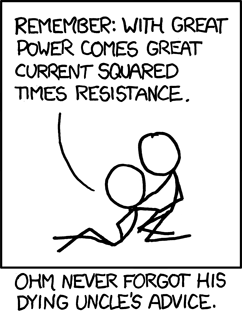Difference between revisions of "643: Ohm"
(Even moar polish.) |
(Added mathiness) |
||
| Line 13: | Line 13: | ||
Physical energy can exist in many different forms. In electrical physics, current flowing through a resistor generates heat. The basic units are defined such that the power (in {{w|Watt}}s) converted into heat is given by the square of the electrical current flowing (in {{w|Amperes}}) multiplied by the resistance of the component (in {{w|Ohm}}s). The unit, Ohm, is named for physicist {{w|Georg Ohm}} who determined experimentally that a given resistor would pass double the current when the electrical pressure ({{w|voltage}}) was also doubled. | Physical energy can exist in many different forms. In electrical physics, current flowing through a resistor generates heat. The basic units are defined such that the power (in {{w|Watt}}s) converted into heat is given by the square of the electrical current flowing (in {{w|Amperes}}) multiplied by the resistance of the component (in {{w|Ohm}}s). The unit, Ohm, is named for physicist {{w|Georg Ohm}} who determined experimentally that a given resistor would pass double the current when the electrical pressure ({{w|voltage}}) was also doubled. | ||
| + | |||
| + | This relationship is summarized by {{w|Ohm's law}}: | ||
| + | :Current = Voltage / Resistance (I=V/R) | ||
| + | :Voltage = Current x Resistance (V=IxR) | ||
| + | :Resistance = Voltage / Current (R=V/I) | ||
| + | |||
| + | {{w|Electric power}} is defined as: | ||
| + | :Power = Current x Voltage (P=IxV - {{w|Joule's laws|Joule's first law}}) | ||
| + | :or by replacing "Voltage" with "(Current x Resistance)" (from Ohm's law): | ||
| + | :Power = Current x (Current x Resistance) = Current^2 x Resistance | ||
==Transcript== | ==Transcript== | ||
| Line 21: | Line 31: | ||
{{comic discussion}} | {{comic discussion}} | ||
[[Category:Physics]] | [[Category:Physics]] | ||
| + | [[Category:Math]] | ||
Revision as of 22:58, 4 January 2013
| Ohm |
 Title text: More generally, with great power comes great dEnergy/dt |
Explanation
This comic is a play on the concepts of power as the human capacity to take action, and power as a strictly defined physical quantity, namely the amount of energy which flows from one locus to another in a unit of time. In calculus, this is expressed as dE/dt, hence the title text declaration that with great power comes great dEnergy/dt—though strictly speaking, great power EQUALS (is identical with) great dEnergy/dt.
The uncle's advice references the comic-book superhero Spiderman. In various versions of Spiderman's origin story, a teenage Peter Parker is brought up by his Aunt May and Uncle Ben. Uncle Ben cautions Peter that "with great power comes great responsibility". Through an incident involving a spider and some cutting-edge technology, Peter Parker acquires spider-like powers—great strength and the ability to adhere to walls and ceilings. Parker fails to use his new powers to stop a mugging; it turns out that the victim is none other than Uncle Ben, who dies from injuries sustained. This failure to save his uncle haunts Parker and drives him to use his new powers for heroic purposes. Visually, this comic looks like the dying Uncle Ben counselling his nephew to use his power responsibly.
Physical energy can exist in many different forms. In electrical physics, current flowing through a resistor generates heat. The basic units are defined such that the power (in Watts) converted into heat is given by the square of the electrical current flowing (in Amperes) multiplied by the resistance of the component (in Ohms). The unit, Ohm, is named for physicist Georg Ohm who determined experimentally that a given resistor would pass double the current when the electrical pressure (voltage) was also doubled.
This relationship is summarized by Ohm's law:
- Current = Voltage / Resistance (I=V/R)
- Voltage = Current x Resistance (V=IxR)
- Resistance = Voltage / Current (R=V/I)
Electric power is defined as:
- Power = Current x Voltage (P=IxV - Joule's first law)
- or by replacing "Voltage" with "(Current x Resistance)" (from Ohm's law):
- Power = Current x (Current x Resistance) = Current^2 x Resistance
Transcript
- [Ohm is holding his uncle by the shoulders.]
- Uncle: Remember: With great power comes great current squared times resistance.
- Narrator: Ohm never forgot his dying uncle's advice.
Discussion
"who determined that a given resistor would pass double the current..." -Actually, this is true only of ohmic resistors, which have constant resistance. Wire resistors, which I'm assuming are what Ohm used, are essentially ohmic for low voltage/current, but their resistance increases at high voltage because they give off dramatically more energy as heat. Other types of resistors have different behaviour. For example, semiconductors have low resistance in one direction and high resistance in the other. Probably someone should correct this! Sciepsilon (talk) 01:51, 1 December 2013 (UTC)
- Somebody really should not. 108.162.219.223 06:34, 24 December 2013 (UTC)
Funnily enough, the Dutch word for "Uncle" sounds similar to "Ohm", though it is spelled differently (Oom). 162.158.111.229 11:02, 6 May 2017 (UTC)
"... both the origin story of spider-man and Ohm's law deal with power". No, Ohm's law doesn't mention power at all. 108.162.250.29 09:30, 26 July 2017 (UTC)
What does the Trivia mean?? 2017 series of Spiderman comics presumably, but is Uncle Ben's quote, "With great..." a pseudo-formula? What would that imply? Potentially he claims responsibility is proportional to to power, such that his quote is "R = k dE/dT for a constant k," but if this is the correct interpretation it is not clear... R128 (talk) 15:12, 8 December 2025 (UTC)